This is second post in the series of the “Nuts and Bolts” education series about fasteners. This article is part 1 in a series of 3 covering Nails.
First, a little nail terminology. There are three main parts of the nail: the head, the shank and the point.
![]()
![]() The nail head is the wide, flat section at top which is struck (generally with a hammer) to drive the nail into the material.
The nail head is the wide, flat section at top which is struck (generally with a hammer) to drive the nail into the material.
asdfasd
![]() The nail shank is the middle of the nail which provides the holding power.
The nail shank is the middle of the nail which provides the holding power.
asdf
The nail point is the sharp tip of the nail which penetrates the material.![]()
asdf
asdf
There are several types of heads, shanks and points which we’ll cover in part 4 of this nail series.
Additionally, nails have various sizing. Generally, nails are measured by size, gauge and head size. The size is the length of the nail, measured from under the nail head to the tip of the point. Size is measured in inches in the United States, or millimeters elsewhere. Alternatively, size can be measured in pennies (“D” symbol); e.g. in Common Nails, size 1 1/4″ is also 3D, whereas 6″ is 60D. Gauge is the diameter of the nail shank. And head size is the diameter of the head.
Nails can be grouped in four basic categories: General Construction, Outdoor Construction and Roofing & Siding . This article focuses specifically on the General Construction group.
Within the General Construction category are four sub-categories: General Construction, Finish & Trim Work, Flooring & Masonry and Miscellaneous.
General Construction
 Common Nails are the most popular and versatile of the nail family. They’re used in construction, carpenty and framing applications. They have a larger shank which provides greater resistance to bending.
Common Nails are the most popular and versatile of the nail family. They’re used in construction, carpenty and framing applications. They have a larger shank which provides greater resistance to bending.
asdf
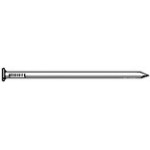 Box Nails are used for construction, carpentry, framing and box making. They have a smooth, slender shank which helps to reduce wood splitting.
Box Nails are used for construction, carpentry, framing and box making. They have a smooth, slender shank which helps to reduce wood splitting.
asdfas
Duplex Nails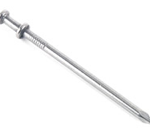 are used in temporary construction where the nails will be removed, thus the second head remains exposed. Such typical jobs would be concrete forming and scaffolding.
are used in temporary construction where the nails will be removed, thus the second head remains exposed. Such typical jobs would be concrete forming and scaffolding.
asdf
 Framing Nails are used on construction jobs where their slender shank (thinner than a common nail but thicker than a box nail) aids in being driven into the material quickly and easily.
Framing Nails are used on construction jobs where their slender shank (thinner than a common nail but thicker than a box nail) aids in being driven into the material quickly and easily.
asdf
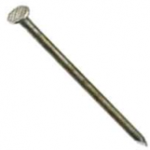 Sinker Nails are used in construction, carpentry and framing. They have a checkered, countersunk head allowing them to sink flush with the material surface. They also have a vinyl-coated smooth shank for simpler installation and additional holding power.
Sinker Nails are used in construction, carpentry and framing. They have a checkered, countersunk head allowing them to sink flush with the material surface. They also have a vinyl-coated smooth shank for simpler installation and additional holding power.
asdf
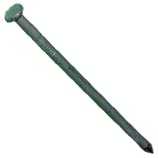 Cooler Nails are used for general construction and framing. They are closest to sinker nails, except their head is flat instead of countersunk.
Cooler Nails are used for general construction and framing. They are closest to sinker nails, except their head is flat instead of countersunk.
asdfsd
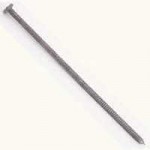 Polebarn Nails are hardened yielding greater strength for load-bearing wooden structures where holding power is essential.
Polebarn Nails are hardened yielding greater strength for load-bearing wooden structures where holding power is essential.
asdfsad
 Fence Staples are just what they sound like — they’re used for attaching woven wire fence, welded fence or barbed wire to wooden fence posts.
Fence Staples are just what they sound like — they’re used for attaching woven wire fence, welded fence or barbed wire to wooden fence posts.
asdfasd
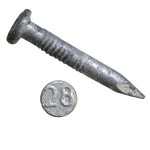 Joist Hanger Nails are for attaching joist hangers (seen to the right) to wood studs. They have a short, heavy gauge which provide increased holding power without entirely penetrating the wood.
Joist Hanger Nails are for attaching joist hangers (seen to the right) to wood studs. They have a short, heavy gauge which provide increased holding power without entirely penetrating the wood.
asdfdfasdfasdfdsf
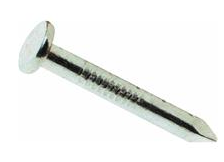 Truss Nails are designed to attach truss plates (seen to the right)
Truss Nails are designed to attach truss plates (seen to the right) between multiple pieces of wood. Several Truss Nails are typically used in truss plates so they are made thinner than joist hanger nails to avoid wood splitting.
Finish & Trim Work
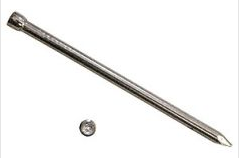 Finishing Nails are used for trim and fine, detailed finishing work. They have a small diameter and cupped head so they can be countersunk beneath the material surface, for a finished appearance.
Finishing Nails are used for trim and fine, detailed finishing work. They have a small diameter and cupped head so they can be countersunk beneath the material surface, for a finished appearance.
asdfCa
![]() Casing Nails are similar to Finishing Nails but have a heavier gauge for door jams and window mouldings.
Casing Nails are similar to Finishing Nails but have a heavier gauge for door jams and window mouldings.
asdf
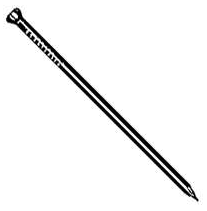 Trim Nails are also referred to as Hardwood Trim Nails are used for fastening hardwood mouldings and have a brad-style head, which is easy to conceal.
Trim Nails are also referred to as Hardwood Trim Nails are used for fastening hardwood mouldings and have a brad-style head, which is easy to conceal.
asdf
Flooring & Masonry
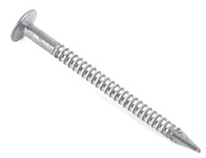 Underlayment Nails are used when laying plywood or subfloors over existing wood floors or floor joists. Their shank is ribbed for greater holding power, similar to threads on a screw.
Underlayment Nails are used when laying plywood or subfloors over existing wood floors or floor joists. Their shank is ribbed for greater holding power, similar to threads on a screw.
asdf
![]() Cut Floor Nails secure hardwood strip flooring to the subfloor as well as wood framing or furring strips to brick, block or concrete. They are often used in restoration jobs, as they are the “antique” version of today’s Flooring Nails (see below). The wider nail side is driven parallel to the wood grain.
Cut Floor Nails secure hardwood strip flooring to the subfloor as well as wood framing or furring strips to brick, block or concrete. They are often used in restoration jobs, as they are the “antique” version of today’s Flooring Nails (see below). The wider nail side is driven parallel to the wood grain.
asdf
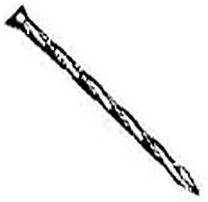 Flooring Nails are just what they sound like.. nails used to secure hardwood strip flooring to the subfloor.
Flooring Nails are just what they sound like.. nails used to secure hardwood strip flooring to the subfloor.
asdf
![]() Cut Masonry Nail are used to attach wood to cinder block, mortar joints, brick walls or fresh concrete. Their blunt point and tapered shank help reduce splitting.
Cut Masonry Nail are used to attach wood to cinder block, mortar joints, brick walls or fresh concrete. Their blunt point and tapered shank help reduce splitting.
asdf
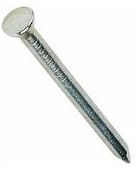 Masonry Nails are used for attaching furring strips and floor plates to uncured concrete.
Masonry Nails are used for attaching furring strips and floor plates to uncured concrete.
asdf
asdf
 Masonry “Stub” Nails are similar to regular Masonry Nails except they have a larger diameter head. This variation is typically used in applications where a smooth masonry style nail is required; e.g. fastening pipe conduit, switch boxes, corner beads or wire mesh to masonry walls.
Masonry “Stub” Nails are similar to regular Masonry Nails except they have a larger diameter head. This variation is typically used in applications where a smooth masonry style nail is required; e.g. fastening pipe conduit, switch boxes, corner beads or wire mesh to masonry walls.
asdf
![]() Metal Round Cap Masonry Nails have a beveled washer around the head to help secure insulation to exterior surfaces. They are fluted to penetrate masonry without cracks.
Metal Round Cap Masonry Nails have a beveled washer around the head to help secure insulation to exterior surfaces. They are fluted to penetrate masonry without cracks.
asdf
 Tension Pins are used to attach furring strips, clips, hangers, etc to concrete blocks or mortared joints.
Tension Pins are used to attach furring strips, clips, hangers, etc to concrete blocks or mortared joints.
asadf
Miscellaneous
![]() Spikes are used when securing railroad ties, landscaping timbers and thick members used in log home construction, as they typically start in smallest lengths of 7 inches.
Spikes are used when securing railroad ties, landscaping timbers and thick members used in log home construction, as they typically start in smallest lengths of 7 inches.
asdf
![]() Gutter Spikes, no surprise, are used to attach gutters. They have thinner shanks and larger heads than spikes.
Gutter Spikes, no surprise, are used to attach gutters. They have thinner shanks and larger heads than spikes.
asdf
asdfasdf\
![]() Panel Board Nails attach panel boards to wood furring strips or studs.
Panel Board Nails attach panel boards to wood furring strips or studs.
asdf
 Furring Nails are used mainly on stucco projects where wire mesh needs to be secured to the exterior wall for application of stucco mud.
Furring Nails are used mainly on stucco projects where wire mesh needs to be secured to the exterior wall for application of stucco mud.
asdfads
![]() Wrought Head Cut Nails are used on restoration jobs where an antique look is the goal, with their 3-sided head and black oxide coating.
Wrought Head Cut Nails are used on restoration jobs where an antique look is the goal, with their 3-sided head and black oxide coating.
asdf
![]() Foundry Nails are used for foundry casting work, concrete form work and metal sculpturing.
Foundry Nails are used for foundry casting work, concrete form work and metal sculpturing.
asdf
 Hinge Nails have a rounded head and are used in antique hinges and face-nailing doors.
Hinge Nails have a rounded head and are used in antique hinges and face-nailing doors.
asdf
asdfadsf
![]() Nursery Nails or Pin Nails help fasten burlap around tree and shrub root balls, to help protect the plant and retain water.
Nursery Nails or Pin Nails help fasten burlap around tree and shrub root balls, to help protect the plant and retain water.
adsf
![]() Pallet Nails are spiral riveted which provides exceptional holding power for wooden pallet
Pallet Nails are spiral riveted which provides exceptional holding power for wooden pallet 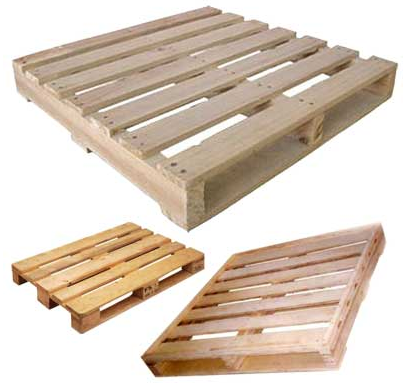 construction and durability. They have round, well-centered heads which feed cleanly through automated nailing machines.
construction and durability. They have round, well-centered heads which feed cleanly through automated nailing machines.
asdf
asdf
Check back in for part 2 of this series where we’ll delve into the Outdoor Construction category of nails.



Trackbacks & Pingbacks